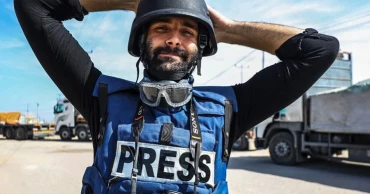Committee to Protect Journalists
Photojournalist Motaz Azaiza from Gaza says ‘Last time you see me with this heavy, stinky vest’
Palestinian photojournalist Motaz Azaiza has announced his departure from the conflict-ravaged Gaza Strip. “I had to evacuate for many reasons,” Azaiza shared on platform X, expressing his gratitude and urging prayers for Gaza.
Azaiza has emerged as a crucial media figure in the embattled Gaza Strip. With over 18 million Instagram followers and a significant presence on X, he has been a primary source of live updates during the Israel-Hamas conflict, as reported by Al Arabiya.
In a heart-wrenching Instagram video, Azaiza, clad in his blue press vest – a symbol of a journalist’s non-combatant status in war zones – declared, “This is the last time you will see me with this heavy, stinky vest.” The video poignantly captures his farewell to Gaza, surrounded by friends and family who assist in removing his press vest and embrace him in a final goodbye.
Read more: States are obliged to prevent crimes against humanity and genocide, UN Committee stresses
Azaiza's impactful presence on social media has given millions worldwide a personal glimpse into the Gaza war, fostering a deep emotional bond between him and his followers. His absence, particularly when not posting for extended periods, prompts a flood of concerned comments about his safety. Azaiza has courageously documented Israeli airstrikes, often amid the devastation of destroyed homes.
Originally focusing on everyday life in Gaza, Azaiza’s work shifted to covering Israel’s military operations, including the wars in 2014 and 2021. Remarkably, his Instagram following skyrocketed from 25,000 to 18 million in just over 100 days since the onset of Israel’s military action following Hamas’ attack on October 7. “We are a nation that is getting killed and we’re trying not to be ethnically cleansed,” Azaiza stated in a post.
Tragically, over 80 journalists, predominantly Palestinians, have lost their lives in Israeli strikes since October 7, as per Reporters Without Borders (RSF). The United Nations Human Rights Commissioner has raised alarms over the unprecedented death toll among journalists in Gaza. The US-based Committee to Protect Journalists (CPJ) reported that the first 10 weeks of the war have been the deadliest for journalists in a single location in recent history.
Israel has consistently denied targeting journalists, asserting its focus on Hamas. Meanwhile, on January 9, Israel’s Supreme Court declined an international media request for unrestricted access to Gaza.
Read more: Israeli strikes across Gaza kill dozens of Palestinians, even in largely emptied north
1 year ago
CPJ seeks impartial investigation into assaults on journalists covering recent political rallies
Bangladesh authorities must immediately and impartially investigate the assaults on at least 27 journalists covering recent political rallies and hold the perpetrators accountable, the Committee to Protect Journalists (CPJ) has said.
On October 28, at least 27 journalists covering rallies in Dhaka were attacked.
CPJ spoke to journalists who accused BNP supporters of attacking the journalists.
Md Rafsan Jani, a crime reporter for the daily Kalbela newspaper, told CPJ that he was filming BNP supporters assaulting police officers when two demonstrators approached him and took his phone and identification card.
A group of BNP supporters then surrounded Jani and beat him with iron rods, sticks, and pipes as he repeatedly identified himself as a journalist, he said, adding that he managed to escape after around 20 minutes.
CPJ, rights groups call for stopping ‘harassment’ of journalist Rozina
As of November 1, his items had not been returned.
The CPJ also took note of The Daily Star report that claimed Awami League demonstrators beat the daily Kalbela reporter Abu Saleh Musa while covering their rally.
“The attacks on at least 27 Bangladeshi journalists covering recent political rallies in Dhaka must see swift and transparent accountability,” said CPJ Program Director Carlos Martínez de la Serna.
“The leadership and supporters of the Bangladesh Nationalist Party and the Awami League, as well as police, must respect the rights of journalists to freely and safely report on the lead-up to the upcoming election scheduled for January,” he said.
SA Masum, a photographer for the daily Inqilab newspaper, told CPJ that he was taking photos of a confrontation between Awami League and BNP supporters when his head was repeatedly struck from behind with what he suspected to be a bamboo stick, knocking him unconscious while the attackers, whom he did not identify, continued to beat him.
Bystanders at the scene rescued Masum and took him to the hospital, where he was treated for a concussion and severe bruising and open lesions throughout his body, according to the journalist, who shared photos of his injuries with CPJ.
Md Sirajum Salekin, a crime reporter for the Dhaka Times, told CPJ that he was on his motorcycle on the way to cover clashes at the chief justice’s residence when a vehicle hit his motorcycle from behind, causing him to fall and break two bones in his right leg.
Record number of journalists jailed worldwide in 2020: CPJ
Salekin said he believed he was targeted because he was wearing his press badge and his motorcycle was marked with a sticker of the Dhaka Times.
Mohammad Ali Mazed, a video reporter for the French news agency Agence France-Presse, told CPJ that he was covering a clash between police and BNP demonstrators while holding a camera and press identification when five to six demonstrators surrounded him.
The demonstrators damaged Mazed’s camera and other news equipment and beat him on his head, back, and right shoulder with bamboo sticks for around three minutes until the journalist fled the scene with the assistance of bystanders, he said.
CPJ names Shahidul Alam among four for Int’l Press Freedom Awards 2020
Sazzad Hossain, a freelance photographer working with Bangla Tribune and international outlets, including the British newspaper The Guardian and photo agency SOPA Images, told CPJ that BNP protesters threw broken bricks at him and trampled him while he was covering a clash with police.
Salahuddin Ahmed Shamim, a freelance photographer reporting for the news agency Fair News Service, told CPJ that he was covering BNP protesters assaulting police officers when seven to eight of the party’s supporters surrounded him, beat him in the back with bamboo sticks, and kicked him for around 15 minutes.
Two journalists who spoke to CPJ — Sheikh Hasan Ali, chief photojournalist for Kaler Kantho newspaper, and Ahammad Foyez, senior correspondent for New Age newspaper — said they were struck with rubber bullets when police attempted to disperse BNP protesters, leaving them with minor injuries.
Ali told CPJ that an unidentified man hit the Kaler Kantho photographer Lutfor Rahman with a bamboo stick on his right shoulder while covering the same clashes.
Md Hanif Rahman, a photographer for Ekushey TV, told CPJ that he and Ekushey TV reporter Touhidur Rahman were covering an arson attack on a police checkpoint when they were surrounded by a group of 10 to 12 men who beat him with pipes and sticks and pushed Touhidur.
Rabiul Islam Rubel, a reporter for the daily Kalbela, told CPJ that he was among a crowd of BNP supporters while covering the clashes at the chief justice’s residence when 15 to 20 men threw bricks at him while shouting that journalists are “government brokers.”
Jony Rayhan, a reporter for the daily Kalbela, told CPJ that BNP supporters beat him while covering their rally. Rayhan was also injured by a sound grenade that landed in front of him while police were trying to disperse the demonstrators, he said.
Salman Tareque Sakil, chief reporter for Bangla Tribune, told CPJ that he sustained a leg fracture after a brick was thrown at him while covering the BNP rally.
Jubair Ahmed, a Bangla Tribune reporter, told CPJ that while police were dispersing BNP demonstrators, a tear gas shell landed in front of him, blurring his vision before the protesters trampled him while fleeing the scene.
Tahir Zaman, a reporter for the news website The Report, was also injured by a rubber bullet while covering clashes at the BNP rally, CPJ said.
Read more: Day 3 of blockade: 4 vehicles burnt in Dhaka, Narayanganj so far
2 years ago
Why press freedom matters
In 1991, a group of African newspaper journalists came together in the capital of Namibia to issue the Windhoek Declaration, which asserted that, “[t]he establishment, maintenance and fostering of an independent, pluralistic and free press is essential to the development and maintenance of democracy in a nation, and for economic development.” The date of the Declaration's adoption, May 3, was subsequently declared as World Press Freedom Day, that was observed in Bangladesh as well as around the world this past week.
Freedom of expression and access to factual and accurate information provided by independent media are foundational to democratic societies. Under the Universal Declaration of Human Rights, freedom of expression includes the right of all individuals “to seek, receive and impart information and ideas through any media and regardless of frontiers.” Yet the outlook today for the rights of journalists around the world remains grim.
Also read: Bangladesh drops one notch in World Press Freedom Index
The Committee to Protect Journalists (CPJ) reported that in 2020, the number of journalists killed in retaliation for their reporting more than doubled, with Mexico and Afghanistan seeing the largest number of killings. According to CPJ, the number of journalists jailed for their reporting in 2020 reached its highest level since the organisation began keeping track, with China, Turkey, and Egypt imprisoning the most reporters last year. Unfortunately, the pandemic has provided a pretext for repressive governments to intensify pressure on independent media. It is exactly in that kind of hostile environment that the exercise of freedom of expression, especially by members of the press, becomes even more crucial in alerting the public to abuses and corruption and in countering dangerous misinformation and disinformation.
At least 247 journalists were reportedly subjected to attacks, harassment, and intimidation in 2020. More than 900 cases were filed under the draconian Digital Security Act (DSA) with nearly 1,000 people charged and 353 detained – many of them journalists. The DSA continues to be used to harass and indefinitely detain journalists, activists and others, resulting in a chilling effect on expression of dissent. In such a situation, it is perhaps not surprising that Bangladesh has slipped one notch in this year's World Press Freedom Index, by Reporters Without Borders, also known as Reporters Sans Frontières (RSF). The country was ranked 152nd out of 180 countries while its position was 151st last year. Even within South Asia, a region that has grown particularly notable for its growing curbs on press freedom, Bangladesh ranked last, behind countries like Afghanistan and Pakistan.
Also read: CPJ names Shahidul Alam among four for Int’l Press Freedom Awards 2020
Throughout the COVID-19 pandemic, journalists and media workers have been on the front lines to keep the public informed, at significant risk to their own health. Till April, 48 Bangladeshi journalists had died of the virus, one of the highest tallies in the world. Yet they must remain relentless in their quest to uncover the truth, for any society that fails to appreciate their worth can only be poorer for it.
4 years ago
Record number of journalists jailed worldwide in 2020: CPJ
A record number of journalists were imprisoned globally during 2020 as authoritarian regimes sought to suppress their critical viewpoints on the Covid-19 pandemic or political instability, the Committee to Protect Journalists (CPJ) has said.
5 years ago
CPJ names Shahidul Alam among four for Int’l Press Freedom Awards 2020
The Committee to Protect Journalists named prominent Bangladeshi photo journalist Shahidul Alam and three others from Iran, Nigeria, and Russia for the 2020 International Press Freedom Awards.
5 years ago


.jpg)




